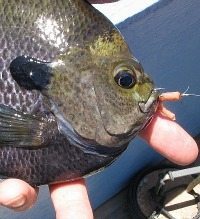 Everybody probably knows of or has a favorite lake that seems to be a big bass producer. Research sheds some interesting perspective on what factors might be the largest determinants of big bass growth. I use the term “might” because the research was actually carried out on another member of the family, the bluegill. But afterall, bass are just giant sunfish, right?
Everybody probably knows of or has a favorite lake that seems to be a big bass producer. Research sheds some interesting perspective on what factors might be the largest determinants of big bass growth. I use the term “might” because the research was actually carried out on another member of the family, the bluegill. But afterall, bass are just giant sunfish, right?
‘Examining Interpopulation Variation in Bluegill Growth Rates and Size Structure: Effects of Harvest, Maturation, and Environmental Variables’, by Hoxmeier, et. al. sampled bluegill across 23 small lakes in Illinois covering all latitudes from the Wisconsin border down to the Ohio River. Big bluegill populations are about as rare and delicate as big bass populations, and we think we know quite a bit about the basic factors that contribute to these bigger fish, but this study arrived at some different conclusions.
Quite simply, there were 4 factors that were most responsible for quality populations and growth of large bluegill.
- Temperature (the most important factor, warmer being better)
- Water transparency (clearer was better)
- Prey availability (more of the right kind is good)
- Size at sexual maturity (males only)
Could it actually be this simple? The warmer the water the faster the growth and the longer the growing season (sound familiar with bass, the South having larger bass in general). The clearer the water, the more likely that a predominant sight feeder such as bass could feed effectively. Prey availability for adults was third most important. Juveniles can feed on lots of options, but for maximum growth, high abundance of the right type prey at the right time of the year is important. The last, size of males at sexual maturity, matches previous studies that suggest timing is influenced by the size of the nesting males: larger males tend to spawn earlier than smaller males.
Interesting is that harvest and density dependent growth didn’t factor high in this survey, though on an individual lake basis these factors can be important. See if these keys sound a lot like the conditions on your local big bass lakes.

























admin (mostly Jay)
July 31, 2012 at 1:30 pm
So…size of females is less important, meaning earlier spawns with bigger males are better?
Brian
July 31, 2012 at 7:55 pm
Many studies seem to suggest this is the case, and as such, the next logical assumption is that there must be some biological advantage gained for this to occur. BP Follow-up post to this particular aspect shortly…